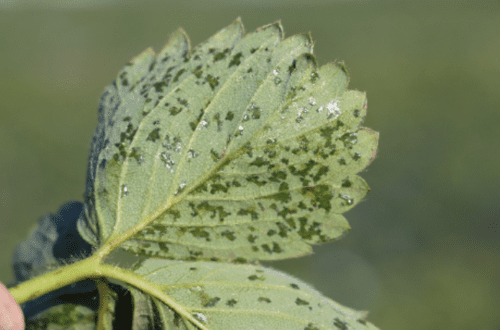Mar 23, 2024Angular leaf spot troubles California strawberry growers
Editor’s note: This is a post from the Cal Poly Strawberry Center’s blog, written by Gerald Holmes, director of the center, and Shashika Hewavitharana, assistant professor and strawberry plant pathologist.
We are seeing quite a bit of angular leaf spot (ALS) in our fields and getting some calls about it in other areas of the state. Angular leaf spot is a bacterial disease caused by Xanthomonas fragariae. It typically shows up this time of year when rains are more frequent.
The optimum temperature of the pathogen is ~68º F and it is known to be killed above 90º F. The splashing water will spread the pathogen to wherever the splashing takes it. You can diagnose this disease easily in the field. Look for the “windows” in the leaves when held up to a bright light/sun (picture 1). On a dewy morning, the lesions will show bacterial ooze that looks gummy when wet and shiny (like lacquer) when dry (picture 2).


The most effective way to manage this disease is preventing it from getting established. It can come in on the transplants. During cool, wet weather (like we’ve been having) the disease can spread quickly and turn leaves necrotic. The good news is that it will subside once the rain stops. So, one very good course of action this time of year is to do nothing and let the plants recover as they push out new growth under drier conditions.


As far as sprays go, there are three products you can use:
- Copper containing products (there are so many!)
- Bacillus amyloliquefaciens (Serifel)
- Acibenzolar-S-methyl (Actigard)
Check the efficacy table for the efficacy ratings (https://ipm.ucanr.edu/agriculture/strawberry/fungicide-efficacybiocontrols-and-natural-products/). You can only prevent future spread of the pathogen. You will not be able to cure existing infections.
There are undoubtedly differences in cultivar susceptibility to ALS but unfortunately, we don’t have any data on this yet.















